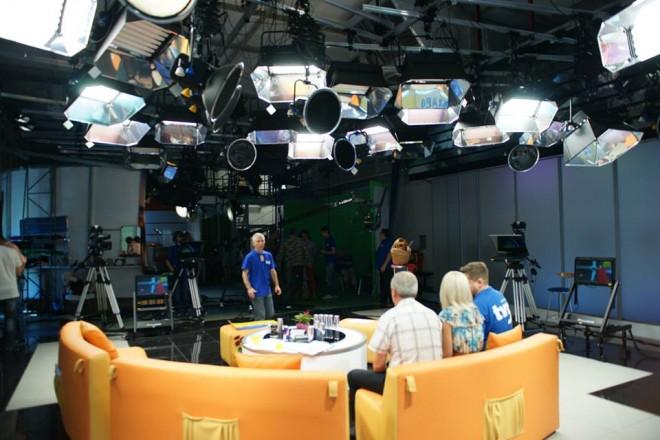In 2008, the First National TV Channel’s technical fleet was replenished with two modern stations: a two-camera SNG machine with the ability to expand to four cameras for broadcasting on the basis of a Mercedes Sprinter, and the first station in Ukraine based on a Ford Expedition SUV for shooting news, including in hard-to-reach places.
In news production, it is very important not only to be the first on the scene, but also to be the first to cover the event. Breaking news and live broadcasts increase the ratings and prestige of the TV company and maximize audience coverage.
That is why in 2008, the First National TV Channel’s technical fleet was replenished with two modern stations: a two-camera SNG machine with the ability to expand to four cameras for organizing broadcasts based on a Mercedes Sprinter, and the first station in Ukraine based on a Ford Expedition SUV for shooting news, including in hard-to-reach places.
Tasks: “live” news
“The most important task we face is to promptly collect, process and publish information,” says Valeriy Vergelesov, deputy head of the technical support complex of the Novosti TV channel of the First National TV Channel. “If a viewer is offered a choice between live or recorded news, 95% will choose live news. After all, it is much more interesting – a person empathizes, being a real witness to what is happening. To maximize coverage of the territory, you need to show what is happening directly from the scene whenever possible. Therefore, we were tasked with building two mobile TV stations with the ability to beam up to the satellite and broadcast live.”
Ford is a reporter, and Mercedes is a correspondent who studies the material in more detail and does more time and work.
“The company has a fairly large fleet of PTCs (four), but there is not a single satellite station,” added Ruslan Tkachenko, chief producer of the NTCU information service. “Therefore, we have to either cooperate with other companies or be tied to our cable network, which, although quite developed, always “chains” the machine to a certain point where we can work. If an event takes place far from our location, it is very uncomfortable to work. We are deprived of the basic ability to respond quickly to any events, and to present the event competently, not to mention promptly include it in the news. In addition, in the Ukrainian market, First National has exceptional opportunities for live broadcasts of many important state events: Independence Day celebrations, public events on May 9, the anniversary of the Holodomor, etc. Broadcasts and live events are our brand. So satellite stations are an urgent issue for us, and satellite stations that can operate in news mode are simply an urgent need.” Thus, the need for two types of PTS was identified: one for sports and news broadcasts and the other for live news broadcasts. The systems should have different priorities: the first one should be fault-tolerant and, therefore, 100% reserved for all major functional blocks, the second one should be mobile and be able to deliver a journalist to the most inaccessible places.
The solution: a mobile office and an all-terrain reporter
Efficiency and compactness are important for news vehicles, because a long, bulky, heavy machine is slow to get to a point, can block traffic and get stuck in the city. A small, lightweight car can go anywhere. At the same time, the vehicle must be powerful enough to transport people and equipment. As a result, two solutions were selected in August 2007: a mobile TV station based on a Mercedes Benz Sprinter 515 CDI for broadcasting and a mobile TV station based on a Ford Expedition 4×4 XLT for live news broadcasts.
- Ukraine’s first off-road DSNG PTS for shooting in hard-to-reach places
- ergonomics
- a fully equipped commentary desk
- energy independence of both machines
- PTCs are ready to work without an escort vehicle
- DSNG stations are thought out to the smallest detail
The project is characterized by carefully thought-out solutions. The stations are designed primarily to solve news-related tasks, so it was necessary to maximize compatibility with the digital news complex of the First National TV Channel. The Ford station uses an Ikegami DNS-33W camera that uses Editcam tapeless shooting technology, the same as the one used in the journalistic complex. The Avid Xpress Pro nonlinear editing stations with Mojo SDI that came with the first and second machines support Editcam drives and operate in the same environment as the newsroom. In other words, the footage recorded on hard disks can be used at editing stations in the PTS and/or in the newsroom.
Thus, the work in both PTCs is compatible with the future newsroom at the hardware level, at the software level, at the level of file encodings and camera work. Journalists, cameramen and engineers working in news can easily work on PTCs with the same editing stations without the need to retrain. All kinds of program graphics, design style – all of this can be easily cloned without any additional time costs. It is also possible to change the number of Editcam cameras in accordance with the current specific task and work with the number that is needed.
Mercedes has a Swe-Dish DriveAway 150 KM satellite dish, while Ford has a lightweight Drive Away 120 KM dish. Both dishes have the ability to automatically point to a satellite with GPS fixation. In the machine intended for broadcasting, transmitters and modulator encoders in the satellite part, as well as video and audio paths are reserved. RossVideo Synergy 100 is used as the main video console, and the bypass is implemented on a Network Electronics (now Nevion) matrix switcher. A Makie was used as the main console in the sound path, and an Alesis in a rack-mounted version was used as a backup. All the important points of both the video and audio paths are routed to matrix switches, which serves as another layer of protection. The clock generator is based on IQ modular solutions from Snell & Wilcox, and this unit is also reserved.
“A poorly prepared broadcast on one of the commercial channels means simply no broadcast, while the announced, announced and unavailable broadcast of a state event is a challenge to Ukraine’s authority, a reason for gossip, a national problem. We cannot afford any non-technological solutions,” said Ruslan Tkachenko.
Conversion, signal distribution, time-shift correction, and synchronization of external signals are implemented on Snell & Wilcox and RossVideo solutions. In the smaller machine, the routing takes place on a Network Electronics router. No special effects are required for information inclusions, the main task is to combine several signals in a clean transition, if necessary, or to feed the source that came through this router to the program.
Both machines are completely energy-independent – their own built-in generators (not remote, but built-in, operating from the vehicle’s common fuel tank) allow them to work in the field (literally). Of course, when working in a settlement, it is possible to power up from the city’s network. In the event of problems with power supply from the city, thanks to the presence of UPS, the station will switch to an autonomous power supply from the generator without interruption.
The ergonomic organization of workplaces is very important for mobile systems. Mercedes has three workstations for a sound engineer, a director, and an engineer. In the same compartment, there is a table on which the installation station with all communications is located. In addition, the passenger seat next to the driver has an additional soundproof workstation with the ability to read and comment on events. “Commercial channels never have such tasks as we do,” says Ruslan Tkachenko. “No one has to show, for example, the Yalta summit in the Livadia Palace, and such events require a commentary seat. We received a car with a commentary seat next to the driver with the ability to connect a microphone and control the signal on the driver’s LCD information display. The car will mostly be operated in a different mode, but knowing that such a situation is possible, we anticipate it. Even if it happens once a year, it should be done comfortably and efficiently. The place is soundproofed, and you can comment on events or read there.”
The SNG project based on Ford Expedition was implemented for the first time in Ukraine, and almost entirely by the integrator, including coaching, internal design of the vehicle and all other work except for the electrical and satellite parts. To ensure work in hard-to-reach places, we analyzed vehicles with all-wheel drive and a sufficiently high ground clearance – the task was to build a station based on an SUV. The choice fell on the Ford Expedition, which provides sufficient working space. In other cars, it is impossible to place equipment, make comfortable workplaces and still maintain stability. Of course, this is a non-standard vehicle – it has an increased cargo capacity and a number of options for optimal use of space.
The cameras can be connected to the analog and digital SDI inputs on the machine. If the cameras are connected via SDI, it is possible to use embedded audio, so that both audio and video can be transmitted over a single coaxial cable. Ford can work with four external sources: two digital SDI and two analog signals.
“We assumed that one camera would be enough on a Ford SUV because it can go everywhere, and more will be used to shoot in hard-to-reach places and operational situations where there is no time to deploy multiple cameras, although two cameras can be connected if necessary,” says Valeriy Vergelesov.
Mercedes currently has two cameras with the possibility of expanding to four in the future so that the station can provide high-quality coverage of official events and other events. In order to conduct full-fledged broadcasts of official events with the participation of members of the Government, the Verkhovna Rada, and the President, we must quickly get to the scene and ensure the highest quality of all technological elements.
“Mercedes is a full-fledged satellite PTS for small broadcasts and simple conferences,” Ruslan Tkachenko comments. “Now there are two cameras, but there is a possibility of expanding to four cameras. This is a mobile correspondent center with the ability to conduct briefings, editing and live broadcasts.
Ford will drive up any mountain, drive on any sidewalk in the city and still provide power. It is designed specifically for filming, editing, and live broadcasting. The TLC camera, which is included with the machine, can be included in the satellite station path. That is, a driver, a satellite engineer, a cameraman, and a journalist get into the car, go on a business trip to the scene, shoot, transfer, edit, and record a large amount of video material, and then immediately use this camera. The cameras are compatible with those provided in the new Ikegami Editcam information system. Mercedes broadcasts and conducts teleconferences, while Ford shoots news and makes live broadcasts. Ford is a reporter, and Mercedes is a correspondent who studies the material in more detail, does more long and hard work.”
“In the Ukrainian television market, First National has exceptional opportunities for live broadcasts of important events,” comments Ruslan Tkachenko, chief producer of the National Television Company of Ukraine’s information service. “And these are events of national importance: Independence Day, parades, May 9, the anniversary of the Holodomor, etc. Broadcasts and live events are our brand. So satellite stations are an urgent issue for us, and satellite stations that can work in news mode are simply an urgent need.
The integrator completed the task in full. The Mercedes-based station has a very ergonomic workspace and is designed to be compatible with the future newsroom. In Ukraine, no one has ever built a satellite station on the basis of a jeep, we have only seen such solutions at exhibitions. But it’s one thing to have an exhibition, and quite another to perceive a machine from the point of view of an operator. But it’s one thing to have an exhibition, and quite another to perceive a machine from the point of view of an operator. When you work at night, you need a light to shine at this point, and here you need to put journalistic notes … All these “little things” are discovered in the course of direct work with the machine.
The integrator’s specialists were very attentive to our wishes, provided for all the little things, put shelves, extension cords, etc. where necessary. We are very pleased with the result.”
“There has never been a jeep-based SNG in Ukraine before, so this was the first such solution,” said Valeriy Vergelesov. “Naturally, we expected that, as often happens with the first pancake, there would be some inconsistencies, inconsistencies, but to my surprise, we did not have any significant problems. All the wishes we discussed were taken into account almost immediately, and we were offered high-quality equipment for ascending to the satellite, as well as the receiving and transmitting parts. We coordinated the location of the equipment in the machine and the arrangement of functional elements.
According to our request, the integrator made a special structure on the roof to cover the dish from possible branches and stones, to protect it from wind and dirt – the dish should be open in any case, but its side is protected. All wishes were met, down to the smallest detail: additional elements, drawers for documentation, etc. After all, the main task is an unaccompanied car, so we had to take into account all the nuances.
The machines are built with a view to future development, which is already inherent in them, and we just need to add additional equipment. In order to easily integrate the PTS with the TV company’s news complex in the future, space was provided for future camera channels. The Ford-based station will be able to connect two cameras with triaxial adapters, which means that when we have additional cameras, we will immediately install them in the car without modifying anything. It is also possible to connect additional VCRs.
Both machines were delivered within the contractual timeframe. It was a fruitful collaboration. “
2008
